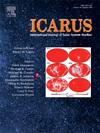Comparing Navcam dust devil detections to transient daytime convective vortex signatures in REMS pressure and ultraviolet data
IF 3
2区 物理与天体物理
Q2 ASTRONOMY & ASTROPHYSICS
引用次数: 0
Abstract
The Mars Science Laboratory (MSL) Curiosity rover has collected over seven Mars Years (MY) of meteorological data. We compare visible dust devil detections in Navigational Camera (Navcam) observations to signatures detected using the Rover Environmental Monitoring Station (REMS) pressure and Ultraviolet (UV) Sensors. Using methodology from previous work, we search for pressure drops and corresponding transient decreases in the UV signal to detect dust-laden vortex signatures that can be compared to dust devil detections from Navcam. Results from these detections show a strong seasonality and topographical influence in pressure drops, but coincident UV drops, which are indicative of dust-laden vortices, tend to be more frequent in certain locations and do not strictly follow this seasonality. Diurnal patterns in dust devil detections by REMS compare well with Navcam detections, with a strong increase in these detections near 10:00 LTST, a peak near local noon, a gradual decrease in afternoon hours, and some interannual variability. UV detections fall off towards Marker Band Valley, an area with high surface thermal inertia and limited sand cover, as do Navcam detections, suggesting that sand availability plays an important role in where dust devils are forming.
比较Navcam沙尘暴探测与瞬态对流涡旋特征在REMS压力和紫外线数据
火星科学实验室(MSL)的好奇号探测器已经收集了7个火星年(MY)的气象数据。我们比较了导航相机(Navcam)观测到的可见尘暴检测与漫游者环境监测站(REMS)压力和紫外线(UV)传感器检测到的特征。利用以前工作的方法,我们在紫外信号中寻找压力降和相应的瞬态下降,以检测尘埃飞扬的涡流特征,这些特征可以与Navcam的尘暴检测相比较。这些检测结果表明,气压降有很强的季节性和地形影响,但同时出现的紫外线下降(表明有灰尘的涡流)在某些地方往往更频繁,而且不严格遵循这种季节性。与Navcam相比,REMS探测到的沙尘暴的日变化规律较好,在LTST 10:00附近有明显的增加,在当地中午附近有一个高峰,在下午逐渐减少,并且有一定的年际变化。紫外线探测到的信号落向标记带谷(Marker Band Valley),这是一个具有高地表热惯性和有限沙尘覆盖的区域,Navcam探测到的信号也是如此,这表明沙尘的可用性在沙尘暴形成的地方起着重要作用。
本文章由计算机程序翻译,如有差异,请以英文原文为准。
求助全文
约1分钟内获得全文
求助全文
来源期刊

Icarus
地学天文-天文与天体物理
CiteScore
6.30
自引率
18.80%
发文量
356
审稿时长
2-4 weeks
期刊介绍:
Icarus is devoted to the publication of original contributions in the field of Solar System studies. Manuscripts reporting the results of new research - observational, experimental, or theoretical - concerning the astronomy, geology, meteorology, physics, chemistry, biology, and other scientific aspects of our Solar System or extrasolar systems are welcome. The journal generally does not publish papers devoted exclusively to the Sun, the Earth, celestial mechanics, meteoritics, or astrophysics. Icarus does not publish papers that provide "improved" versions of Bode''s law, or other numerical relations, without a sound physical basis. Icarus does not publish meeting announcements or general notices. Reviews, historical papers, and manuscripts describing spacecraft instrumentation may be considered, but only with prior approval of the editor. An entire issue of the journal is occasionally devoted to a single subject, usually arising from a conference on the same topic. The language of publication is English. American or British usage is accepted, but not a mixture of these.
 求助内容:
求助内容: 应助结果提醒方式:
应助结果提醒方式:


